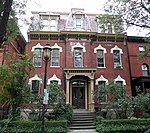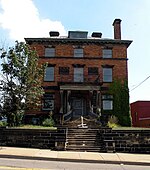Hoene-Werle House
Allegheny County, Pennsylvania Registered Historic Place stubsHouses completed in 1887Houses in PittsburghHouses on the National Register of Historic Places in PennsylvaniaNational Register of Historic Places in Pittsburgh ... and 1 more
Pittsburgh building and structure stubs

The Hoene-Werle House in the Manchester neighborhood of Pittsburgh, Pennsylvania, was built in 1887 as a double house with a courtyard in the rear and a complex molded brick and millwork cornice in the front. German immigrants Herman H. Hoene, who owned a retail piano store, and Fred H. Werle, a druggist, originally owned the house.The house was abandoned then acquired by the city in the 1970s and then bought in the 1980s and restored. It was listed on the National Register of Historic Places in 1984. It is also part of the Manchester Historic District
Excerpt from the Wikipedia article Hoene-Werle House (License: CC BY-SA 3.0, Authors, Images).Hoene-Werle House
Merchant Street, Pittsburgh
Geographical coordinates (GPS) Address Website Nearby Places Show on map
Geographical coordinates (GPS)
| Latitude | Longitude |
|---|---|
| N 40.451388888889 ° | E -80.016388888889 ° |
Address
Community College of Allegheny County
Merchant Street
15290 Pittsburgh
Pennsylvania, United States
Open on Google Maps










